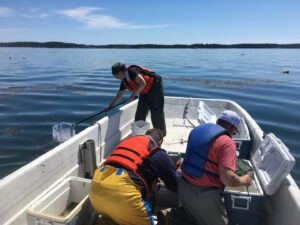Lumpfish
Cyclopterus lumpus

The use of cleaner fish in the netpen production of salmon has gained popularity in recent years due to the complex challenge of sea lice infestation that salmon farmers face. Sea lice, parasitic copepods from the Caligidae family, have had a major impact on the salmon aquaculture industry, causing significant economic loss to salmon producers worldwide. In 2016 alone, sea lice infestations caused a 10% drop in the world’s supply of farmed salmon.

Several methods, including thermal baths and chemical treatments, have been developed to combat sea lice in netpen salmon production. These methods are costly and require significant handling of the salmon during production leading to increased stress for the fish. The use of cleaner fish has been shown to control sea lice infestations in salmon pens without detriment to the salmon.

Young lumpfish opportunistically graze on sea lice when they are placed in the netpens with the impacted salmon. This method of biological control of sea lice is not only effective, but beneficial to the health and welfare of the salmon as deployment of lumpfish into the salmon pens is not a stressful event for the salmon.
The use of lumpfish as biological control of sea lice is relatively new. This method was first investigated within the last decade in Norway and has since gained popularity with salmon producers worldwide. We hope to bring this method to the US and Maine with the development of a locally sourced broodstock.


Norway is the world’s largest producer of salmon, contributing to over half of the world’s share of salmon produced in 2020, so it should come as no surprise that Norway also currently leads the world in lumpfish production, with over 30 million fish produced in 2018. Canada is the largest producer of salmon in North America and the fourth largest producer worldwide with a 6% share of worldwide production. In 2019 Canada produced 2 million lumpfish, but they have plans to increase their cleanerfish production capacity via the construction of a commercial lumpfish hatchery in Newfoundland. Once completed, Canada’s lumpfish production will more than double.

As part of the newly formed U.S. Lumpfish Consortium, CCAR’s cleaner fish program began in 2018 with the collection of 158 wild juvenile lumpfish. These fish were collected in the summer months from Frenchman Bay and Eastern Bay, just off the coast of Downeast Maine. Over the years we’ve collected over 1,000 fish to use in our breeding program. The consortium’s members also include The University of New Hampshire and The USDA’s National Cold Water Marine Aquaculture Center. In 2019 the group produced a total of 15,000 fish.
